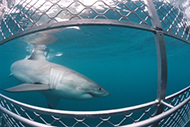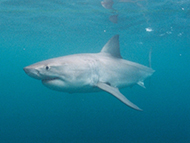
Priorities Action Statement - Actions for Great White Shark
 Great White Shark
Great White Shark
© Andrew Boomer
Recovery actions
Collate and review existing information
- Update and refine information on existing Biologically Important Areas (BIAs) identified as part of DoEs Marine Bioregional Plans, and seek to identify new BIAs as information from research and other processes becomes available (Medium priority).
- Assess the availability of information on regional threats to Great White Sharks (Medium priority).
- Identify and promote opportunities for regional collaboration to promote the recovery of Great White Sharks (Low priority).
Community and stakeholder liaison, awareness and education
- Engage cage dive operators in shark research and education programs (Medium priority).
- Ensure effective communication by the Commonwealth with relevant stakeholders in regards to any changes in legislative arrangements concerning Great White Sharks (Medium priority).
- Update DoE's Great White Shark recovery plan web page to reflect the most current information on the Great White Shark, which can thereby be used as a primary source of information. Ensure the web page is presented in a form that is easily understood by the public and is linked to the relevant website of other jurisdictions with an interest in conservation of Great White Sharks (Medium priority).
- Encourage recreational fishers to utilise the sighting program to report and provide, where possible, photographic evidence of sightings of and interactions with Great White Sharks. Requested information from fishers should include estimated number, size and weight of sharks, as well as site location and depth (Low priority).
- Work with recreational fishing associations to ensure they continue to provide information on the protection of Great White Sharks to their members (Low priority).
- Promote community education on the threatened status of Great White Sharks (Low priority).
Compliance / enforcement
- Strengthen awareness of, and compliance with, the requirement to report Great White Shark bycatch and mortality in commercial fisheries, aquaculture operations and recreational and charter fishing operations (High priority) .
Enhance, modify or implement NRM planning processes to minimize adverse impacts on threatened species
- Ensure actions to reduce levels of Great White Shark mortality are considered when relevant state and territory fisheries management plans are reviewed (High priority).
- Ensure that fisheries management plans that are reviewed for accreditation under the EPBC Act contain actions that are consistent with the recovery of the Great White Shark (where relevant), including minimising the impacts of bycatch and recording of all interactions (Medium priority).
- Maintain the current review processes (by the NSW and Qld governments) of the effect of shark control programs on the Great White Shark. Ensure similar review of any new shark control programs put in place during the life of this recovery plan (Medium priority).
- Use BIA maps to help inform the development of appropriate conservation measures, including through the application of advice in DoEs Marine Bioregional Plans on the types of actions that are likely to have a significant impact on the species. Update such conservation measures as new information becomes available (Medium priority).
Research / monitoring
- Develop and implement a monitoring program (involving a range of factors, e.g. survival, connectivity, fecundity, age-at-maturity, absolute abundance) to assess population trends and dynamics (High priority).
- Monitor the bycatch and mortality of Great White Sharks in relevant fisheries (all interactions are recorded) and report annually to DoE (High priority).
- Continue to evaluate alternatives to beach meshing/drumlining, including the use of non-lethal methods or alternative strategies (High priority).
- Continue research to locate habitat critical to the survival of the Great White Shark, including pupping, nursery and foraging areas. Develop and apply a suite of criteria to characterise and identify habitats critical to the survival of the Great White Shark (High priority).
- Collect, analyse and disseminate age, growth, reproduction, survival, mortality and diet information to improve understanding of the population dynamics, habitat requirements and the role of Great White Sharks as an apex predator (High priority).
- Continue to collect and analyse biological material for toxicology research and genetic analysis (for example to determine the stock structure, inbreeding depression, population boundaries and abundance); improve coordination of reporting and sampling programs; and coordinate the collation of results and the storage of collected genetic and biological material (High priority).
- Examine habitat use (with a focus on identifying breeding areas, pupping grounds and juvenile aggregation sites) and regional connectivity across life history stages through the use of conventional and electronic tagging technologies including acoustic listening station networks and satellite tagging (High priority).
- Investigate post-release mortality issues (High priority).
- Develop a national database to record Great White Shark interactions with recreational and commercial fishers (Medium priority).
- Where relevant, work with the aquaculture industry to improve reporting of interactions with Great White Sharks (Medium priority).
- Develop mechanisms and protocols that facilitate reporting by recreational fishers of interactions with Great White Sharks. Mechanisms chosen should foster the understanding that any reported interaction will be received without prejudice (Medium priority).
- Quantify, through monitoring, reports and where necessary estimates, of Great White Shark bycatch, mortality and non-lethal interactions, in recreational fishing sectors and report annually to DoE (Medium priority).
- Shark control programs to continue to report catches annually to the New South Wales and Queensland state governments (Medium priority).
- Where feasible and practical, undertake biological recording and sampling of Great White Sharks caught in shark control programs (Medium priority).
- Develop a tagging program, where appropriate (including genetic sampling, where possible) for Great White Sharks caught in shark control programs, in conjunction with new and existing programs (Medium priority).
- Investigate the impact of increased cage diving activity and develop appropriate management responses if required (Medium priority).
- Require daily logbook reporting of Great White Shark interactions by cage dive operators (Medium priority).
- Investigate and quantify protected shark product in trade (Medium priority).
- Refine and implement techniques (DNA and morphological) to identify shark products (Medium priority).
- Undertake market place testing of shark projects to ascertain the level of supply (Medium priority).
- Monitor Great White Shark occupancy and utilisation of BIAs, particularly habitats critical to the survival of the species (Medium priority).
*(NB: the PAS actions for Great White Shark are taken from the approved Commonwealth recovery plan for this species. NSW DPI will be responsible for implementing only those actions of relevance to NSW).


